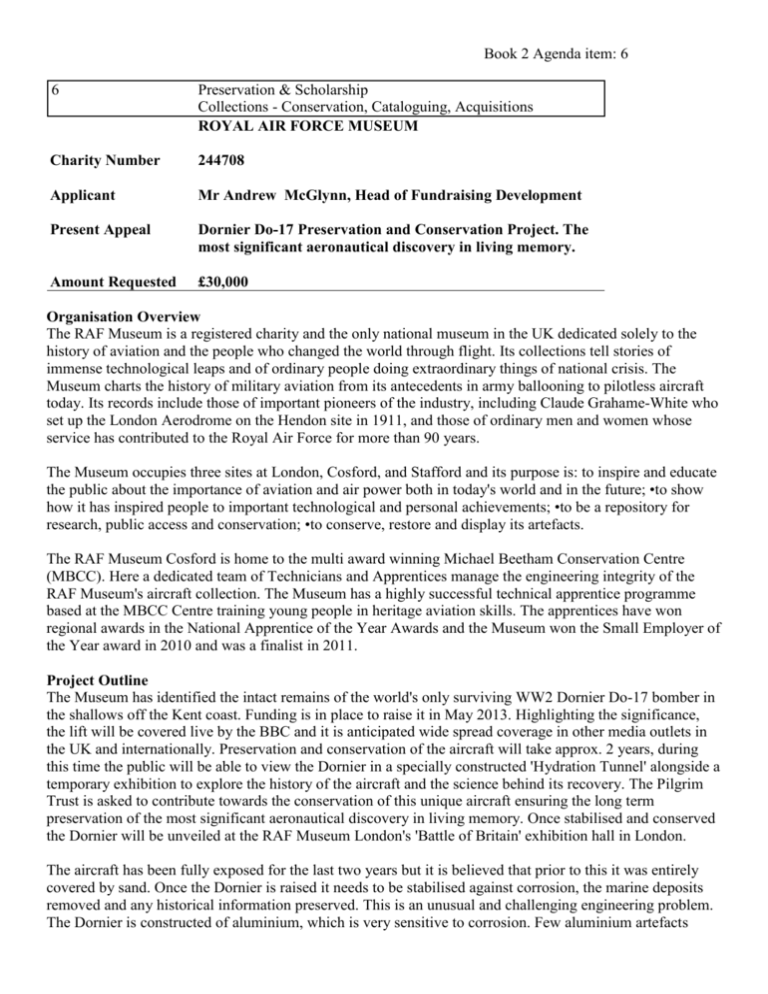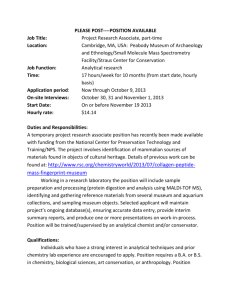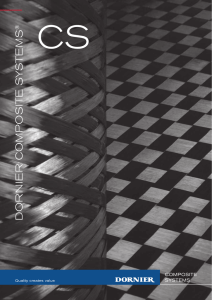RAF-Museum_late-paper-for-Trustees-meeting
advertisement

Book 2 Agenda item: 6 6 Preservation & Scholarship Collections - Conservation, Cataloguing, Acquisitions ROYAL AIR FORCE MUSEUM Charity Number 244708 Applicant Mr Andrew McGlynn, Head of Fundraising Development Present Appeal Dornier Do-17 Preservation and Conservation Project. The most significant aeronautical discovery in living memory. Amount Requested £30,000 Organisation Overview The RAF Museum is a registered charity and the only national museum in the UK dedicated solely to the history of aviation and the people who changed the world through flight. Its collections tell stories of immense technological leaps and of ordinary people doing extraordinary things of national crisis. The Museum charts the history of military aviation from its antecedents in army ballooning to pilotless aircraft today. Its records include those of important pioneers of the industry, including Claude Grahame-White who set up the London Aerodrome on the Hendon site in 1911, and those of ordinary men and women whose service has contributed to the Royal Air Force for more than 90 years. The Museum occupies three sites at London, Cosford, and Stafford and its purpose is: to inspire and educate the public about the importance of aviation and air power both in today's world and in the future; •to show how it has inspired people to important technological and personal achievements; •to be a repository for research, public access and conservation; •to conserve, restore and display its artefacts. The RAF Museum Cosford is home to the multi award winning Michael Beetham Conservation Centre (MBCC). Here a dedicated team of Technicians and Apprentices manage the engineering integrity of the RAF Museum's aircraft collection. The Museum has a highly successful technical apprentice programme based at the MBCC Centre training young people in heritage aviation skills. The apprentices have won regional awards in the National Apprentice of the Year Awards and the Museum won the Small Employer of the Year award in 2010 and was a finalist in 2011. Project Outline The Museum has identified the intact remains of the world's only surviving WW2 Dornier Do-17 bomber in the shallows off the Kent coast. Funding is in place to raise it in May 2013. Highlighting the significance, the lift will be covered live by the BBC and it is anticipated wide spread coverage in other media outlets in the UK and internationally. Preservation and conservation of the aircraft will take approx. 2 years, during this time the public will be able to view the Dornier in a specially constructed 'Hydration Tunnel' alongside a temporary exhibition to explore the history of the aircraft and the science behind its recovery. The Pilgrim Trust is asked to contribute towards the conservation of this unique aircraft ensuring the long term preservation of the most significant aeronautical discovery in living memory. Once stabilised and conserved the Dornier will be unveiled at the RAF Museum London's 'Battle of Britain' exhibition hall in London. The aircraft has been fully exposed for the last two years but it is believed that prior to this it was entirely covered by sand. Once the Dornier is raised it needs to be stabilised against corrosion, the marine deposits removed and any historical information preserved. This is an unusual and challenging engineering problem. The Dornier is constructed of aluminium, which is very sensitive to corrosion. Few aluminium artefacts Book 2 Agenda item: 6 have been recovered from the sea and so best practice and literature is scarce. As a reactive metal, aluminium is particularly prone to localised corrosion damage by any chloride left on the surface once the aircraft leaves the sea. The Museum is working with researchers from Imperial College London to develop new methods to prevent corrosion of the aircraft once it has been lifted from the Channel and to ensure its long term preservation. (An overview of this conservation research is attached). The initial 'post-surface' lift and dock transfer protection process will break the corrosion cycle by minimising the oxygen that reaches the drying surface of the Dornier. This will be achieved by coating the surfaces of the aircraft with a gel-detergent and, following the immediate work to separate wings and fuselage, the sealing of these gel-coated components ready for travel. Following arrival at the Michael Beetham Conservation Centre at Cosford the Dornier will be housed in an innovative and specially constructed 'Hydration Tunnel' where a micro-droplet spray application of water and enviro-friendly chemical mixes will work to preserve the aircrafts structure. Financial Information Organisation Year End Restricted 31/03/12 Income 8,232,992 Expenditure 9,191,188 Total Net Assets Project Overall estimated cost Income RAF Museum purchase grant National Heritage Memorial Fund Friends of the RAF Museum EADS 238 Support Services Public donations Unrestricted Total 2,643,166 2,477,414 10,876,158 11,668,602 61,938,108 £861,229 321,000 343,826 12,000 7,500 10,000 7,000 Requested from the Pilgrim Trust...................................£30,000 Comments This is a very expensive project and although the majority of the money has been raised there is still some £160,000 outstanding. Sarah Staniforth has commented that the conservation proposals are appropriate, "good science and good public access during treatment". However, it is a large project and is likely to go ahead with or without Pilgrim Trust support and the live coverage of the lift on the BBC will undoubtedly generate donations.








